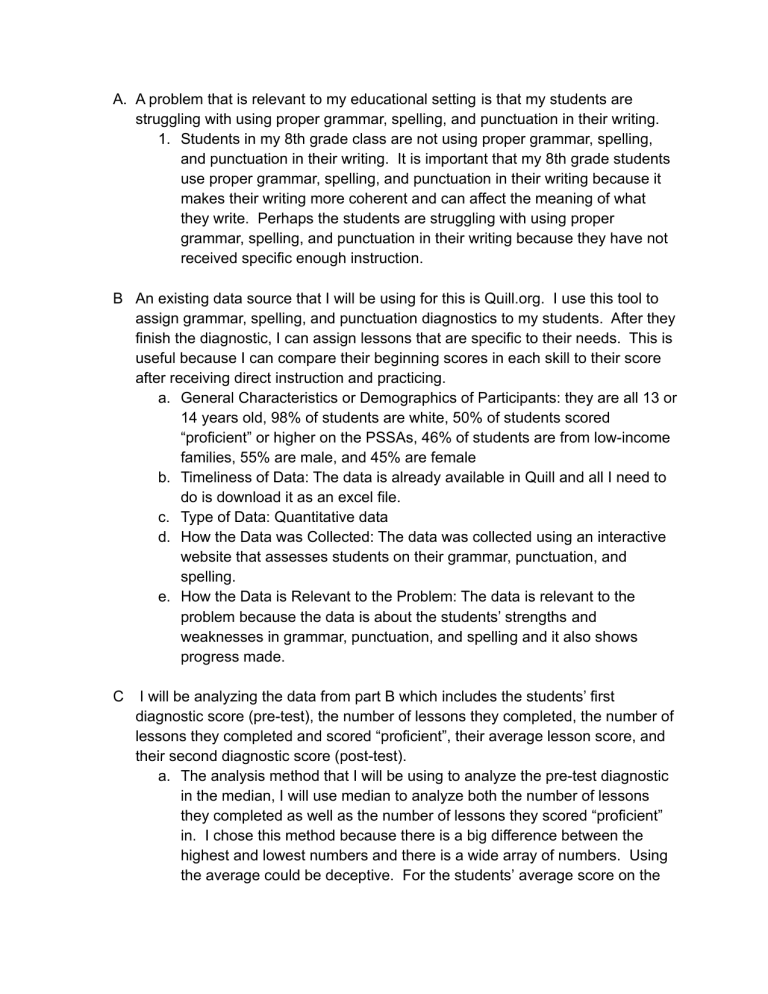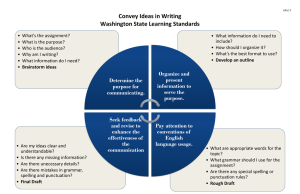
A. A problem that is relevant to my educational setting is that my students are struggling with using proper grammar, spelling, and punctuation in their writing. 1. Students in my 8th grade class are not using proper grammar, spelling, and punctuation in their writing. It is important that my 8th grade students use proper grammar, spelling, and punctuation in their writing because it makes their writing more coherent and can affect the meaning of what they write. Perhaps the students are struggling with using proper grammar, spelling, and punctuation in their writing because they have not received specific enough instruction. B An existing data source that I will be using for this is Quill.org. I use this tool to assign grammar, spelling, and punctuation diagnostics to my students. After they finish the diagnostic, I can assign lessons that are specific to their needs. This is useful because I can compare their beginning scores in each skill to their score after receiving direct instruction and practicing. a. General Characteristics or Demographics of Participants: they are all 13 or 14 years old, 98% of students are white, 50% of students scored “proficient” or higher on the PSSAs, 46% of students are from low-income families, 55% are male, and 45% are female b. Timeliness of Data: The data is already available in Quill and all I need to do is download it as an excel file. c. Type of Data: Quantitative data d. How the Data was Collected: The data was collected using an interactive website that assesses students on their grammar, punctuation, and spelling. e. How the Data is Relevant to the Problem: The data is relevant to the problem because the data is about the students’ strengths and weaknesses in grammar, punctuation, and spelling and it also shows progress made. C I will be analyzing the data from part B which includes the students’ first diagnostic score (pre-test), the number of lessons they completed, the number of lessons they completed and scored “proficient”, their average lesson score, and their second diagnostic score (post-test). a. The analysis method that I will be using to analyze the pre-test diagnostic in the median, I will use median to analyze both the number of lessons they completed as well as the number of lessons they scored “proficient” in. I chose this method because there is a big difference between the highest and lowest numbers and there is a wide array of numbers. Using the average could be deceptive. For the students’ average score on the lessons, I will use the mean because the numbers are all very similar and there are no outliers. b. In each of my classes, Core, College Prep, and Honors, there seemed to be a wide gap between the highest and lowest score. For the most part, students scored as “proficient” in over 90% of the lessons that they did in Quill. In Core, the average lesson score was 88%, in College Prep it was 89.5, and in Honors it was 91%. This tells me that students had a high comprehension level of what they were learning and were applying it correctly. The last thing that I noticed was that there was a definite positive correlation between how many lessons the students scored proficient in and how many points they gained in their post-test. c. D I was able to reach several conclusions based on the data that I collected. a. The first conclusion was that my subjective judgment of my students being behind in their grammar, punctuation, and spelling skills was correct and was supported by their scores in their pre-test. The median score in my Core class was 48%, the median score in my College Prep class was 60%, and the median score in my Honors class was 52%. b. Another conclusion that I came to was that the lessons are effective because the average lesson score across all classes was 89.5% which is much higher than what they received on the pre-test. c. A third conclusion that I was able to make was that students who completed more lessons with a score of “proficient” had a higher improvement between their pre-test and post-test. E I could use the data gathered from this activity to continue to improve instruction. a. The first way I could use it to improve instruction is to provide small group instruction for concepts that students are still struggling with. This will provide students with targeted instruction and more opportunities to practice skills they need to improve. b. Another way that I could use the data to continuously improve instruction is to require students to complete more lessons with a “proficient” score before being able to take the post-test. Since there seems to be a positive correlation between those who complete more lessons proficiently and scoring higher on the post-test, this would improve instruction for students.



